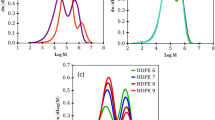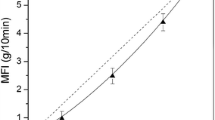Abstract
Linear high-density polyethylenes with molar masses M w between 240 and 1,000,000 g/mol, obtained by metallocene catalysts, were characterized in shear using oscillatory and creep tests. The polydispersities of the molar mass distributions (MMDs) lay between 1 and 16. The resulting zero shear-rate viscosities η0 covered a range from 2.5×10−3 to around 108 Pas. Above a critical molar mass of M c≈2,900 g/mol, the experimental results can be described by the relation η0 ∼ M 3.6w , independently of the MMD. The oscillatory data were fitted with a Carreau–Yasuda equation. The resulting parameters were correlated to molecular structure. The parameter a, being a quantity for the width of the transition between the Newtonian and the non-Newtonian regime, showed a dependence on the molar mass M w but not on M w/M n. The parameter λ of the Carreau-Yasuda equation was found to be the reciprocal crossover frequency for all samples with a log-Gaussian MMD. λ depends on the molar mass M w and also on M w/M n.









Similar content being viewed by others
Notes
This issue does not pose any problem as typical mPE possess only long-chain branches for their highest molecular masses (>M w), which are well detectable.
It is assumed that |η* (ω)| for ω→ 0 is equal to η0 from creep tests. This was confirmed for all samples for which η0 could be determined from both oscillatory and creep tests.
References
Aguilar M, Vega J, Sanz E, Martinez-Salazar J (2001) New aspects on the rheological behaviour of metallocene catalysed polyethylenes. Polymer 42(24):9713–9721
Beer F, Capaccio G, Rose L (1999) High molecular weight tail and long-chain branching in SRM 1476 polyethylene. J Appl Polym Sci 73(14):2807–2812
Carella JM, Graessley WW, Fetters LJ (1984) Effects of chain microstructure on the viscoelastic properties of linear polymer melts: polybutadienes and hydrogenated polybutadienes. Macromolecules 17:2775–2786
Carreau P (1968) Rheological equations from molecular network theories. Ph.D. Thesis, University of Wisconsin, Madison
Coll H, Gilding DK (1970) Universal calibration in GPC: a study of polystyrene, poly-α-methylstyrene, and polypropylene Universal Calibration in GPC. A study of poly-styrene, poly-alpha-methylstyrene, and polypropylene. J Polym Sci A2 (1PA2) 1(8):89–103
Ferry JD (1980) Viscoelastic properties of polymers. Wiley, Chichester
Gabriel C, Münstedt H (2002) Influence of long-chain branches in polyethylenes on linear viscoelastic flow properties in shear. Rheol Acta 41(1–2):232–244
Graessley WW, Edwards SF (1981) Entanglement interactions in polymers and the chain contour concentration. Polymer 22:1329–1234
Jordens K, Wilkes G, Janzen J, Rohlfing D, Welch M (2000) The influence of molecular weight and thermal history on the thermal, rheological, and mechanical properties of metallocene-catalyzed linear polyethylenes. Polymer 41(19):7175–7192
Kazatchkov IB, Bohnet N, Goyal SK, Hatzikiriakos SG (1999) Influence of molecular structure on the rheological and processing behavior of polyethylene resins. Polym Eng Sci 39(4):804–815
Laun HM (1983) Rheologische Eigenschaften und molekularer Aufbau von Kunststoffschmelzen. Verhandlungen DPG VI 18:53
Laun HM (1987) Orientation of macromolecules and elastic deformation in polymer melts. Prog Colloid Polym Sci 75:111–139
Lohse DJ, Milner ST, Fetters LJ, Xenidou M, Hadjichristidis N, Mendelson RA, Garcia-Franco CA, Lyon MK (2002) Well-defined, model long chain branched polyethylene. 2. Melt rheological behavior. Macromolecules 35(8):3066–3075
Luettmer-Strathmann J (2000) Effect of small-scale architecture on polymer mobility. J Chem Phys 112(12):5473–5479
Malmberg A, Liimatta J, Lehtinen A, Löfgren B (1999) Characteristics of long chain branching in ethene polymerization with single site catalysts. Macromolecules 32(20):6687–6696
Malmberg A, Gabriel C, Steffl T, Münstedt H, Löfgren B (2002) Long-chain branching in metallocene-catalyzed polyethylenes investigated by low oscillatory shear and uniaxial extensional rheometry. Macromolecules 35:1038–1048
Pearson DS, Fetters LJ, Graessley WW, Ver Strate G, von Meerwall E (1994) Viscosity and self-diffusion coefficient of hydrogenated polybutadiene. Macromolecules 17:1668
Piel C, Stadler FJ, Kaschta J, Rulhoff S, Münstedt H, Kaminsky W (2005) Structure property relationships of linear and long-chain branched metallocene high density polyethylenes characterized by shear rheology and SEC-MALLS. Macromolecular Chemistry and Physics (in press)
Raju VR, Smith GG, Marin G, Knox JR, Graessley WW (1979a) Properties of amorphous and crystallizable hydrocarbon polymers. I. Melt rheology of fractions of linear polyethylene. J Polym Sci Part B Polym Phys 17:1183–1195
Raju VR, Rachapudy H, Graessley WW (1979b) Melt rheology of linear and star-branched hydrogenated polybutadiene. J Polym Sci Part B Polym Phys 17:1223–1235
Scholte TG, Meijerink NLJ, Schoffeleers HM, Brands AMG (1984) Mark–Houwink equation and GPC calibration for linear short-chain branched polyolefins, including polypropylene and ethylene–propylene copolymers. J Appl Polym Sci 29(12):3763–3782
Stadler FJ, Piel C, Klimke K, Kaschta J, Parkinson M, Wilhelm M, Kaminsky W, Münstedt H (2005) Influence of type and content of very long comonomers on long-chain branching of ethene-/α-olefin copolymers. Macromolecules (in press)
Tobita H (2001) Dimensions of branched polymers formed in simultaneous long-chain branching and random scission. J Polym Sci Part B Polym Phys 39(23):2960–2968
Vega J, Santamaria A, Munoz-Escalona A, Lafuente P (1998) Small-amplitude oscillatory shear flow measurements as a tool to detect very low amounts of long chain branching in polyethylenes. Macromolecules 31(11):3639–3647
Wasserman S, Graessley W (1996) Prediction of linear viscoelastic response for entangled polyolefin melts from molecular weight distribution. Polym Eng Sci 36(6):852–861
Wood-Adams PM (1998) The effect of long chain branching on the rheological behavior of polyethylenes synthesized using constrained geometry and metallocene catalysts. Thesis, McGill University, Montreal
Wood-Adams P, Dealy J, DeGroot A, Redwine O (2000) Effect of molecular structure on the linear viscoelastic behavior of polyethylene. Macromolecules 33(20):7489–7499
Yasuda K (1979) Investigation of the analogies between viscometric and linear viscoelastic properties of polystyrene. Ph.D. Thesis, MIT, Cambridge
Acknowledgements
The authors would like to thank the Deutsche Forschungsgemeinschaft (German Research Foundation) for the financial support of this project. They would also like to thank Mrs. Inge Herzer of the University Erlangen-Nürnberg for the GPC-MALLS measurements. Additionally, discussions with Jens Stange and Dietmar Auhl of the University Erlangen-Nürnberg are gratefully acknowledged.
Author information
Authors and Affiliations
Corresponding author
Rights and permissions
About this article
Cite this article
Stadler, F.J., Piel, C., Kaschta, J. et al. Dependence of the zero shear-rate viscosity and the viscosity function of linear high-density polyethylenes on the mass-average molar mass and polydispersity. Rheol Acta 45, 755–764 (2006). https://doi.org/10.1007/s00397-005-0042-6
Received:
Accepted:
Published:
Issue Date:
DOI: https://doi.org/10.1007/s00397-005-0042-6




